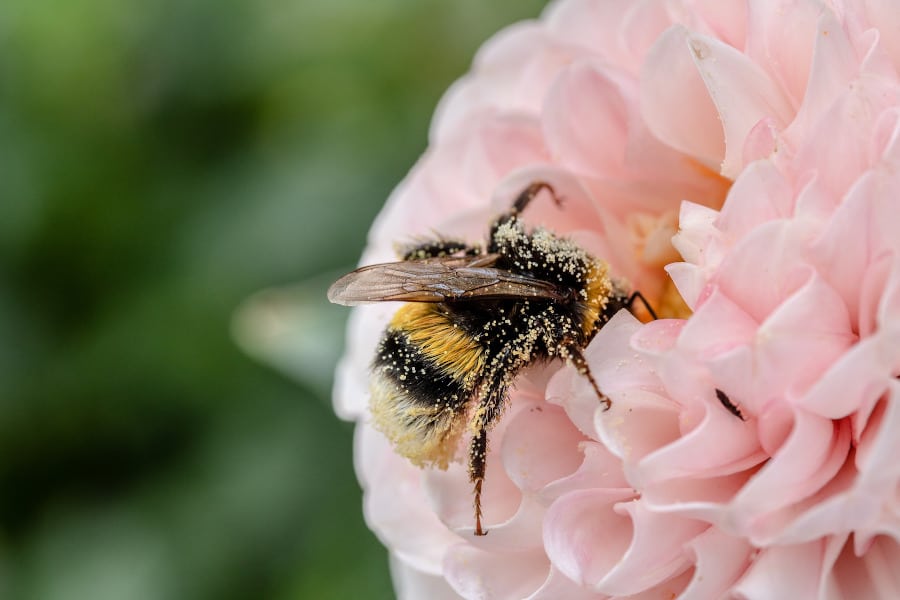*This post contains affiliate links. As an Amazon Associate, I earn from qualifying purchases. Read my Affiliate Links Disclaimer.
Spring is in the air! Flowers are blooming in real life and in prints of your favorite designers. Pollinator fashion is prolific on the runway. Designers love flowers and with flowers come the buzzing of bees, flies, and butterflies – important pollinators.
When visiting flowers to forage on nectar and pollen, pollinators move pollen that gets stuck to their bodies from the anthers (male part of the plant) of one flower to the stigma (female part) of another, allowing for fertilization and therefore reproduction to occur. Without pollinators, many plants cannot reproduce meaning that pollinators are critical for our food supply, worth at least tens of billions of dollars for this ecosystem service.

Bees
The pollinator that usually first comes to mind is the bee. Saying “the” bee is a huge understatement, considering there are 20,000 known species and since many are either undiscovered or not yet described, probably thousands more. The bee we are most familiar with is the honey bee, which collects nectar to make honey stored in hives to help bees survive through the winter when there are no flowering plants. Bees are really cool animals as some species have a highly evolved and complex eusocial system. In this system, there is one reproducing individual (the queen) in which all other adult members care for her and her offspring. Eusociality has been explained by kin selection for years, where individuals benefit by helping others raise young as they share genes and contribute to fitness indirectly, but more recently, scientists have proposed this system has evolved through the defense of a nest and extreme evolution.
Pollinator fashion designers featuring bees included the Chanel couture and Christian Dior Spring 2016 collections with embroidered detailing, earrings, and broaches (I cannot even tell you how much I love these looks!). Unfortunately, bees are in great need of help. The have been in decline for years due to habitat loss (see below how you can help), climate change, pesticides, and disease.
Butterflies
Butterflies are another well-known pollinator and are strong in pollinator fashion, especially for spring. The most iconic butterfly in the United States is the monarch butterfly, known for its incredible migration from the US to Mexico, and similar to bees, in decline. This butterfly also suffers from loss of habitat, and milkweed specifically, in which the caterpillar exclusively eats and the butterflies lay their eggs upon (order and plant some milkweed in your yard here!). Really cool citizen science (meaning you can participate in real science) opportunities exist in monarch butterfly research, resulting in peer-reviewed publications advancing the knowledge of monarchs.
#MargotRobbie wearing a butterfly print dress from at the 'Good Bye Christopher Robin' New York special screening #VersaceCelebrities pic.twitter.com/g7J0PJlH20
— VERSACE (@Versace) October 12, 2017
Birds
Most people think of invertebrate insects when it comes to pollinators, but there are also vertebrate pollinators. Birds make up a big part of pollinator fashion. Hummingbirds in the New World and similar-looking sunbirds in the Old World both feed on nectar and pollinate. Humming birds are a delight when they visit your backyard and I just purchased my first feeder. It’s so much fun to see them come to the yard!
The jungle print shirt is coupled with a pyhton-pattern skirt, sandals and #DGBag. The look is completed with a contemporary pair of #DGEyewear.
— Dolce & Gabbana (@dolcegabbana) May 24, 2020
Discover the look in your nearest boutique: https://t.co/vq017EIqbq#DGSicilianJungle #DGWomenSS20 #DolceGabbana pic.twitter.com/r0firpgDmC
Bats
My favorite pollinator is also a vertebrate, and a pretty unexpected one, the lesser long-nosed bat. You are also probably a fan of this pollinator because this bat is responsible for pollinating blue agave, which is the plant used for making tequila. Despite their importance in a drink many people love, bats tend to be hated (undeservedly so) by people. This bat has therefore suffered because of it and was endangered for years in Mexico.
Due to the amazing dedication of “Bat Man” scientist Dr. Rodrigo Medellin, the endangered species designation of this species was reversed, making a conservation success story for this unlikely pollinator. Medellin is a true conservationist and worked hard to educate the public on the importance of this bat to Mexico’s economy and heritage, find new roosts, and restore habitat. His story is told in the BBC documentary “Natural World: The Batman of Mexico,” which I highly recommend.
The lesser long-nosed bat is back to pollinating blue agaves and making sure there is plenty of tequila for Mexicans and the world to enjoy. Fashion designers need to take note of the Bat Man’s ability to promote this flagship species and create some cool bat-inspired fashions (I could only find one!).
Giles Spring/Summer 2014 pic.twitter.com/Fhlt17lOUY
— cc: (@xxmantra) December 15, 2015
GILES SPRING 2014 COLLECTION – Halloween, but make it fashion. pic.twitter.com/xxZarrkUDe
— no crying in the club (monaco) (@sadaboutchiffon) October 28, 2018
Many More!
There are far too many species in pollinator fashion for one blog post, which truly showcases their importance worldwide. Others include monkeys, lemurs, possums, rodents, wasps, ants, flies, moths, beetles, lizards and snakes. However, the unfashionable trend of pollinators fashion is that most species are in decline. Even if you don’t care about conservation, you should care about your food supply.
One way you can have an impact is by creating pollinator-friendly habitat where you live, and don’t underestimate your neighborhood. A recent study found that bees actually preferred foraging in urban gardens over forests. This is especially important for migrating pollinators so they can have food sources when they stop along their long journey. For specific steps to help pollinators, check out “5 Super Easy Tips for a Wildlife-Friendly Yard.”
*This post was originally featured on The Wildlife SNPits. All photos are courtesy of Vogue.

Love this post? Share it with friends!


